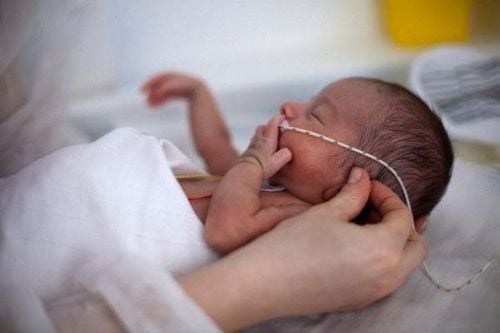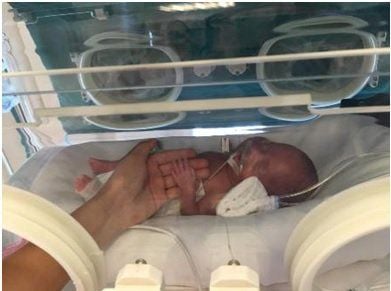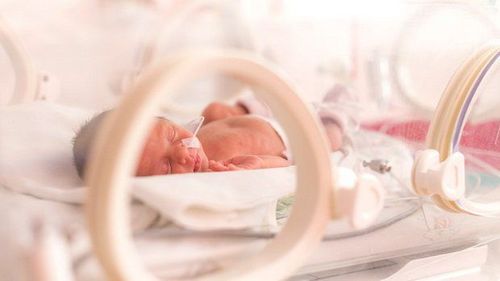This is an automatically translated article.
The article was professionally consulted by BSCK II Tran Lien Anh - Head of Neonatology Department, Vinmec Times City International Hospital. Doctor Lien Anh used to teach neonatal diseases and has a long history of working at the Neonatal Resuscitation Department at the National Children's Hospital. Her strength is resuscitation of severe diseases in infants, treatment of skin diseases, umbilical cord, respiratory and digestive tract infections in infants.Preterm labor before due date is an unexpected event in pregnancy. Babies born prematurely will have many health problems and need to stay in the hospital for a longer follow-up than babies born at full term.
1. What is a premature baby?
Previously, according to regulations, preterm infants were those with birth weight below 2,500g. From 1960 onwards, such a simple definition was found to be inaccurate, easily confused with low birth weight babies, babies born with fetal nutrition. Therefore, the World Health Organization (WHO) has revised the definition, infants born before 37 weeks (counting from the first day of the last menstrual period) are premature babies.Classification of preterm infants
Late preterm birth: from 34 weeks to 36 weeks 6 days. Moderately preterm birth: 32 to < 34 weeks. Very premature birth: ≤ 32 weeks. Extremely preterm birth: < 28 weeks.

Because of early birth, premature babies are at great risk. The lower the gestational age, the higher the risk. Postpartum risks include: respiratory failure, hypothermia, slow closing of the ductus arteriosus, blood sugar instability, body fluid/electrolyte imbalance, pathological jaundice, anemia, malnutrition, infection, hemorrhagic encephalopathy, hearing loss, retinopathy of the eye. .. and sudden death.
The goal of treatment and care of premature babies is to provide reasonable respiratory, circulatory and systemic support, in order to minimize the risks/complications after birth; provide nutrition/energy to help the baby grow and adapt to life outside the womb.
The cost of treatment and care for premature babies is very expensive due to the long hospital stay in the neonatal intensive care unit. In addition, when growing up, especially premature and extremely preterm infants, there may be long-term sequelae (due to the body's immaturity) such as neurological sequelae, either obvious or latent with low intelligence, impaired vision and hearing. And often it is a psychological and financial burden for parents for life.
Trắc nghiệm: Thế nào là trẻ sơ sinh non tháng?
Trẻ sơ sinh non tháng rất cần được chăm và điều trị thật tốt để giúp giảm nguy cơ gặp phải các di chứng về tinh thần, vận động và sự phát triển sau này. Cùng theo dõi bài trắc nghiệm dưới đây để có thể nhận biết trẻ sơ sinh non tháng và có thêm kiến thức chăm sóc, nuôi dưỡng tốt nhất cho trẻ.The following content is prepared under supervision of Thạc sĩ, Bác sĩ y khoa, Ma Văn Thấm , Nhi , Phòng khám Đa khoa Quốc tế Vinmec Dương Đông(Phú Quốc)
2. What causes preterm birth?
Over 50% of preterm labors have no known cause.2.1. Due to pregnancy Premature rupture of membranes easily stimulates uterine contractions, promoting preterm labor. Multiple pregnancies have a shorter mean gestation period than singleton pregnancies. Polyhydramnios, especially when associated with fetal abnormalities, also often causes premature labor and premature birth. Inflammation of the membranes caused by an infection that causes uterine contractions. 2.2. Due to placenta previa, placental abruption causes bleeding before birth. Inadequate fetal nutrition also often leads to preterm labor. 2.3. Due to the mother's inflammatory diseases such as pancreatitis - pyelonephritis, appendicitis, especially when accompanied by fever, it is easy to cause preterm labor. It is hypothesized that the uterus is stimulated by inflammation of the adjacent organs, and is also a result of the release of bacterial endotoxins that increase body temperature. Uterine malformations, underdevelopment of the uterus, and ectopic pregnancy are favorable conditions for preterm birth. If the mother has a history of preterm birth or has had an abortion, a miscarriage will also increase the risk of preterm birth. In addition, habitual factors such as smoking, alcohol consumption or low socioeconomic characteristics also affect early labor. The most important characteristics in this group are poor nutrition, inadequate prenatal care, heavy labor, very young mothers under 20 years old or older mothers over 40 years old.
3. Characteristics of premature babies
In cases where the exact date of the last menstrual period cannot be remembered, it is possible to rely on the external characteristics of the child as well as the neurological manifestations to determine the gestational age relatively accurately.Premature baby's skin looks very succulent, red and blood vessels visible underneath. Lots of fluff and irritants on the skin at birth. The ear cartilage is very soft, the skull is rickety and easily deformed. Breast sprouts are very small, wrinkles on the soles of the feet are sparse. In boys, if born earlier than 33-34 weeks, the testicles are still located in the abdomen or in the inguinal canal, the scrotum is not wrinkled, stretchy and easily edematous according to the child's lying position. In girls, the labia majora does not fully cover the labia majora and clitoris. Premature babies often lie still, have little movement, arms and legs are in a straight position, muscle tone has not yet developed. Primordial neural reflexes such as grasping and sucking are still incomplete. The child's ribcage is still soft, the intercostal muscles are weak, the lungs are not well dilated, the alveoli are immature. Babies breathe through their belly, which swells when they inhale; Sometimes breathing is fast, sometimes breathing stops. Therefore, children are very susceptible to respiratory failure, cyanosis. However, if the child breathes high concentration of oxygen, it damages the optic nerve, causing the child to go blind. In addition, children are very susceptible to cold because their skin area is too large for their body weight, there is no subcutaneous fat layer, and the temperature regulation center in the brain is still immature. Fragile blood vessels, lack of clotting factors, so premature babies are prone to bleeding. Incomplete liver function, lack of bilirubin-metabolizing enzymes, often causes severe and prolonged jaundice in children. Low sugar reserve, small stomach volume, lack of digestive enzymes, so children often have vomiting, abdominal distension, digestive disorders and low blood sugar. In addition, because the immune system is weak and has not received antibodies from the mother, the baby is very susceptible to severe infections, sepsis leading to death.
4. Care and nurturing of premature babies

Caring for children must always respect the rules of sterility, including items intended for children. Maintaining the temperature and humidity of the incubator, according to the desired goal, depending on the gestational age and postpartum age of the baby, it is possible to combine skin-to-skin warmth with the mother as soon as possible.
The means of monitoring children are always set up with alarm points to promptly handle when the child has fast or slow breathing, apnea, hypoxemia, hypothermia, increased or decreased heart rate, blood pressure, cyanosis ,...
Although it is extremely difficult and expensive to feed a premature baby, with a high mortality rate, some children can still grow up healthy and develop like a full-term baby, if supported. right and timely right after birth. Before being discharged from the hospital, mothers and their families need to be thoroughly consulted on breastfeeding methods, alternative nutritional measures (if necessary), ways of care - monitoring - detecting common signs of disease. common in young children. In addition, parents also need to know the schedule to take their children for vaccinations, check their physical and psychological development, and detect abnormalities in vision, hearing, and movement so that they can intervene early and timely. time.
5. Vinmec's achievements in feeding preterm and very premature babies
Vinmec Times City is the only hospital in the North that, over the years, has successfully saved lives without leaving sequelae for most of the premature births. In particular, with extremely premature children (under 1,000 grams), the rate of sequelae is also very low. Typically, two twins have the lowest gestational age, 24 weeks old, born on May 25, 2018 Nguyen Ha Chau weighs 600 grams and Nguyen Ha Vy weighs 600 grams. This success is achieved thanks to the professional staff with in-depth knowledge and modern equipment system.
Neonatal Resuscitation Department is equipped with facilities such as incubator, normal ventilator, high frequency ventilator, nCPAP ventilator, monitor monitor, portable incubator with ventilator... and other equipment always ready to serve. At the same time, thanks to separate boxes and isolation facilities, the ability to control cross-infection is good, ensure a safe environment for children, check physical and psycho-physiological development, and detect early. abnormalities in vision, hearing, and movement for early intervention for children.
In addition, doctors and nurses have in-depth knowledge and skills in Neonatology, especially taking care of premature babies with many years of experience, high sense of responsibility and love for children. . Specialist II Tran Lien Anh - Head of the Department of Neonatology, Vinmec Times City International Hospital with 40 years of experience in neonatology and a member of the Vietnam Neonatal Association.
Up to now, the treatment, care and feeding procedures for premature babies in particular and infants with pathologies in general at Vinmec Times City have always been closely monitored and standardized according to international standards, bring the same efficiency as advanced countries, increase the chances of cure and healthy life for premature babies, increase the chances of infertile families.
To prevent premature birth, in the last 3 months of pregnancy, you should have more frequent antenatal care, especially pregnant women over 35 years old, have a history of premature birth, fetal distress, stillbirth. When there are abnormal signs such as abdominal pain, bleeding, amniotic fluid leakage, ... you should immediately go to a reputable medical facility for examination and treatment of pregnancy intervention.
Vinmec International General Hospital is one of the prestigious medical facilities taking care of premature babies, having saved and nurtured 24 weeks premature babies. Premature babies will be cared for and raised with international standards. Premature births are organized in a methodical manner under the coordination of many specialties: obstetrics, anesthesiology and especially neonatology and paediatrics. This helps to reduce the risks and increase the effectiveness of treatment for health problems that premature babies may have.
To register for an examination with experienced doctors at Vinmec, customers please book an appointment directly at the website for service.

Please dial HOTLINE for more information or register for an appointment HERE. Download MyVinmec app to make appointments faster and to manage your bookings easily.















